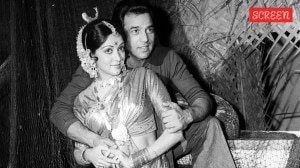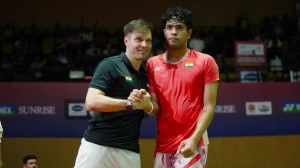Shyamlal Yadav is one of the pioneers of the effective use of RTI for investigative reporting. He is a member of the Investigative Team. His reporting on polluted rivers, foreign travel of public servants, MPs appointing relatives as assistants, fake journals, LIC’s lapsed policies, Honorary doctorates conferred to politicians and officials, Bank officials putting their own money into Jan Dhan accounts and more has made a huge impact. He is member of the International Consortium of Investigative Journalists (ICIJ). He has been part of global investigations like Paradise Papers, Fincen Files, Pandora Papers, Uber Files and Hidden Treasures. After his investigation in March 2023 the Metropolitan Museum of Art, New York returned 16 antiquities to India. Besides investigative work, he keeps writing on social and political issues. ... Read More
Haryana: An electoral history
The small state has often garnered national attention. Its electoral history is dotted with multiple defections — aptly enough, Haryana has gifted to India’s political lexicon its most evocative expression for turncoats.
 Devi Lal, accompanied by his supporters, argues with Governor G D Tapase (left) at Raj Bhavan after the Assembly election of 1982. (Express Archive)
Devi Lal, accompanied by his supporters, argues with Governor G D Tapase (left) at Raj Bhavan after the Assembly election of 1982. (Express Archive)Given its small size, Haryana, which was carved out of undivided Punjab on November 1, 1966, has had a disproportionately large impact on Indian national politics.
For almost 53 of the last 58 years, the state has been ruled by five leaders (and their families) — Bansi Lal, Devi Lal, Bhajan Lal, Bhupinder Singh Hooda, and Manohar Lal.
Haryana is where the expression Aaya Ram, Gaya Ram, a uniquely apt descriptor in Indian politics, was born; it is also perhaps the only state where a Governor was once allegedly manhandled by a claimant to the CM’s post.
Birth of Haryana and the first government of the state
The decision by Indira Gandhi’s government to reorganise the state of Punjab was followed in April 1966 by the appointment of a boundary commission led by Justice Jayantilal Chhotalal Shah of the Supreme Court. Parliament passed The Punjab Reorganisation Act in September 1966, creating the state of Haryana and the Union Territory of Chandigarh. Some Hindi-speaking areas of undivided Punjab were merged with what was then the UT of Himachal Pradesh.
Bhagwat Dayal Sharma, then Minister for Labour and Cooperatives in the government of undivided Punjab, was appointed the first chief minister of Haryana. The state had 54 Assembly seats (out of undivided Punjab’s 154) to begin with, which was increased to 81 in 1967, and 90 in 1977.
Haryana’s first Assembly had 48 MLAs from the Congress, three from the Bharatiya Jana Sangh (BJS), one from the Samyukta Socialist Party, and two Independents.
 Haryana Assembly (1967-2019).
Haryana Assembly (1967-2019).
The first Assembly election, first coalition government
In the election of 1967, the Congress won 48 of the 81 seats, the BJS won 12, Swatantra Party 3, and the Republican Party of India 2. The remaining seats went to Independents.
1967 was a volatile year in Indian politics. The socialist leader Dr Ram Manohar Lohia, Gandhian J B Kripalani, Deendayal Upadhyaya of BJS, and C Rajagopalachari of Swatantra Party led a strong anti-Congress campaign; in some states, the opposition formed a common front, the Samyukta Vidhayak Dal (SVD); and non-Congress governments came to power in West Bengal, Bihar, Kerala, Madras (which was renamed Tamil Nadu in 1969), Orissa, Punjab, Uttar Pradesh, and Madhya Pradesh.
In Haryana, Rao Birender Singh, then Speaker of the Assembly, left the Congress, formed the Vishal Haryana Party, and took oath as CM on March 24, 1967. However, he was soon abandoned by some of those who had joined him from the Congress — and on November 20, 1967, Indira dismissed his government and imposed President’s Rule.
Aaya Ram, Gaya Ram: birth of an enduring expression
The political turmoil of 1967 produced an enduring and evocative Hindi name for the breed of flexible Indian politicians who are called “turncoats” — “Aaya Ram, Gaya Ram”.
After the Congress won a small majority in the 1967 election, Chief Minister Bhagwat Dayal Sharma was sworn in again on March 10. Within a week, however, 12 of the Congress’s 48 MLAs formed a new group called Haryana Congress, and the Independent members in the Assembly formed their own “United Front”. As MLAs continued to switch, the United Front number ultimately reached 48.
One of the Independents was Gaya Lal, MLA from Hasanpur (SC). In the space of nine hours, Gaya Lal switched twice, going in and out of the Congress, and within a fortnight, moved to the United Front. After becoming chief minister, Rao Birender Singh presented Gaya Lal at a press conference in Chandigarh — and memorably declared that “Gaya Ram is now Aaya Ram”.
Then Union Home Minister Y B Chavan later used the expression in Parliament to describe political turncoats.
The 1970s: Bansi Lal, Devi Lal, and Bhajan Lal
After the Congress won a majority in the election of 1968, Indira chose Bansi Lal, a Jat from Bhiwani, to be chief minister. Bansi Lal managed to survive the major split in the Congress in 1969, and stayed in the post until November 30, 1975, when he was moved to the Centre during the Emergency.
Bansi Lal was replaced by another politician from Bhiwani — the Vaishya leader Banarsidas Gupta. After the Janata Party government of Morarji Desai came to power in 1977, Gupta’s government was dismissed along with all other Congress governments in states.
In the election that followed a few weeks of President’s Rule, Janata emerged winner — and Devi Lal, a Jat leader from Sirsa, became chief minister. Two years later, in June 1979, Bhajan Lal, a member of Devi Lal’s ministry, set off with a group of dissidents in a luxury bus and a fleet of cars, touring Alwar, Kota, Agra, Gwalior, Shivpuri, Bhopal, Kanpur, Kolkata, and Mumbai.
For more than two weeks, the group stayed at heritage hotels and resorts, with Bhajan Lal picking up the tab. The pressure on Devi Lal paid off — he resigned, and Bhajan Lal became chief minister on June 29, 1979.
After Indira returned to power at the Centre in January 1980, Bhajan Lal and 37 MLAs of the Janata Party switched to the Congress. As Indira went about dismissing Janata governments in other states, Bhajan Lal continued in power — as a Congress CM.
The 1980s, the years of Devi Lal and Chautala
In the election of 1982, the Congress won 36 seats, Devi Lal’s Lok Dal won 31, and the newly formed BJP won 6. Sixteen seats were won by Independents.
After Governor G D Tapase administered the oath of office to Bhajan Lal as the leader of the single largest party in the House, Devi Lal reached Raj Bhavan along with 45 MLAs and, following an argument, allegedly manhandled the Governor.
About a year before the 1987 election, the Congress replaced Bhajan Lal with Bansi Lal as CM. Devi Lal had by then joined hands with the faction of the Lok Dal led by H N Bahuguna. A second faction of the Lok Dal was led by Ajit Singh, the son of Chaudhary Charan Singh, who had founded the original party. In the election, Devi Lal’s Lok Dal (B) won 60 seats, and his ally, the BJP, won 16 seats.
As the troubles of Rajiv Gandhi’s Congress mounted at the Centre, Chief Minister Devi Lal threw his weight behind the rebel V P Singh, who had quit the Congress and formed the Janata Dal. Devi Lal’s “Green Brigade” contributed greatly to spreading V P Singh’s anti-corruption message — and when Singh became prime minister in December 1989, Devi Lal became his deputy. The chief ministership of Haryana passed to Devi Lal’s son, Om Prakash Chautala.
Between December 1989 and March 1991, Chautala took oath as chief minister thrice. His first stint was the longest, lasting until May 1990, when Banarsidas Gupta replaced him. Chautala returned as CM in July, but was in power for less than a week. Hukam Singh Phogat was chief minister for eight months, after which Chautala returned — this time as a leader of the Samajwadi Janata Party (SJP), the faction of the Janata Dal formed by former Prime Minister Chandra Shekhar.
In the election of 1991, the Congress won 51 of the 90 seats, and Bhajan Lal became chief minister. Chautala’s SJP won 16 seats, and the Haryana Vikas Party (HVP), which Bansi Lal had formed after leaving the Congress, won 15.
Return of Bansi Lal, and of Om Prakash Chautala
For the election of 1996, Bansi Lal tied up with the BJP, and the alliance won 44 of the 90 seats. Devi Lal’s clan, who had formed a state unit of the Samata Party, won 24 seats. Bansi Lal became chief minister.
In 1999, however, the BJP withdrew from the government and allied with Chautala, who became CM for the fourth time that July. In the election of March 2000, Chautala’s Indian National Lok Dal (INLD) won 47 seats, and he retained the chief ministership.
Chautala’s 2000-05 tenure was marred by allegations of corruption involving himself and his sons Ajay and Abhay. Devi Lal’s successors were unable to take forward his legacy in the same way as Lalu Prasad and Nitish Kumar could in Bihar, and Mulayam Singh Yadav did in Uttar Pradesh. Over the years, members of his family faced political setbacks and suffered jail sentences, and his political legacy fragmented among his grandsons and great grandsons. Dushyant Chautala, great grandson of Devi Lal, allied with the BJP to prop up Manohar Lal’s second government.
After 2005: Decade each of Rohtak raj, saffron sarkar
In 2005, the Congress won 67 of the 90 seats, pushing INLD and BJP to the fringes, and propelled Rohtak-based Bhupinder Singh Hooda to the chief ministership. Hooda remained chief minister until 2014, when he was pushed out by anti-incumbency, allegations of corruption, and the Narendra Modi wave.
In the election of 2014, the BJP won 47 seats, a historic majority of its own. Non-Jat communities rallied behind the party across the state, and Manohar Lal Khattar, a former RSS pracharak and low-profile leader who had worked with Modi earlier, became CM.
In 2019, Manohar Lal returned as CM, but the BJP was reduced to 40 seats. Ahead of the 2024 Lok Sabha election, an increasingly unpopular Manohar Lal was replaced by another non-Jat leader, Nayab Singh Saini. Khattar contested the Lok Sabha election, and is now a union minister.






- 01
- 02
- 03
- 04
- 05
































